Fast Fashion Destroyed Our Concept of Price and Value
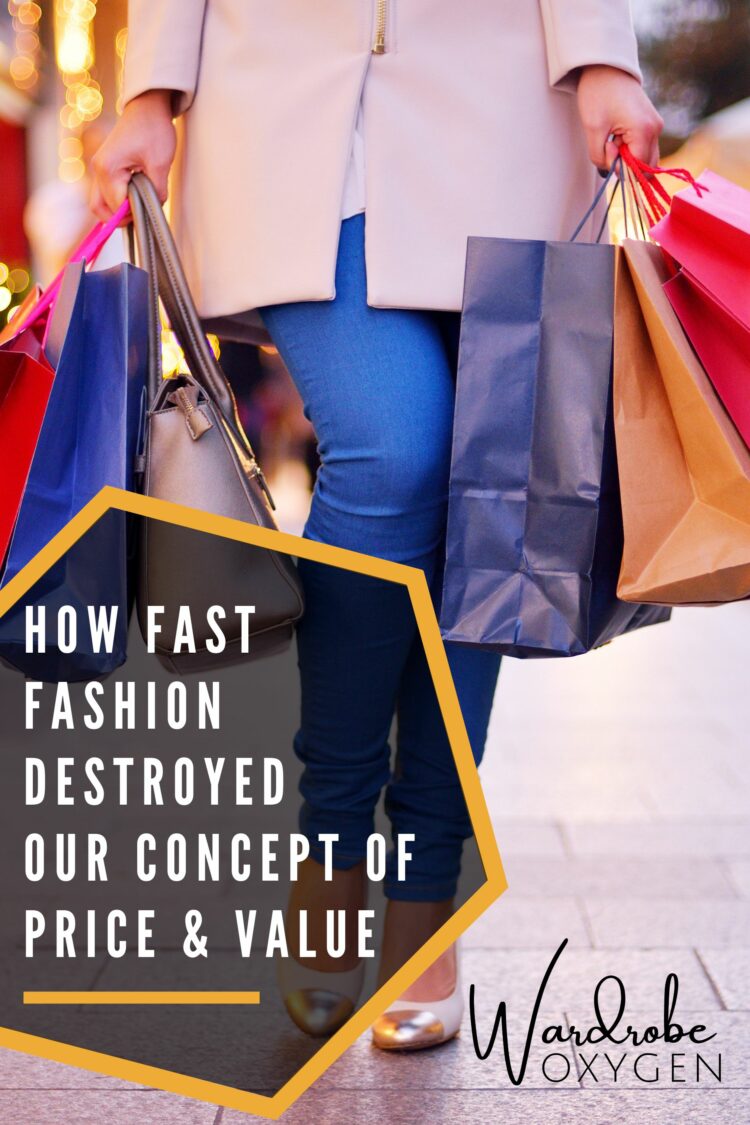
In 2000, you could go to the mall and buy a pair of jeans at Gap, Levi's, or Express for less than $50. If you went to buy a car, on average it would cost $21,000 and gas for it would be about $1.50 a gallon. If you bought a home in 2000, on average, it would cost $200,000.
In 2020, gas was about $2.17 a gallon. The average price for a car was around $40,000 and the average cost of a home in the United States was $329,000. Life in the United States cost almost twice what it did two decades prior, yet we were still buying jeans for around $50.
How Companies Make Cheaper Products
The price of an item drops when there is a way to make it cheaper. And there are a lot of ways to make things cheaper:
- Cheaper materials (wood laminate versus hardwood plank floors)
- Buying in bulk (McDonald's fries versus fries made by your local independent cafe)
- Cheaper manufacturing (overseas factories where cost of living is lower and regulations are not as strict versus made in the U.S.)
- Technology innovation (replacing paid laborers with machines)
The reason jeans are still $50 two decades years later is a mix of these four methods, but primarily numbers one and three. And this is because fast fashion completely fucked up the apparel market.
This post was originally published a year ago, but I updated it and republished it because it's a reminder we all need on a regular basis.
Fast Fashion Destroyed Our Concept of Price and Value
In 2000, we had fast fashion but it wasn't as popular or accessible. Forever 21 existed, but it wasn't until 2005 when it seemed to be in every American mall. Amazon was still a place to buy books, and if you weren't shopping for clothing in brick and mortar stores, it likely was through a mail-order catalog. Clothing in big box discount retailers like Walmart were mocked for being cheap and unstylish.
In 2000, budget-friendly fashion came from the thrift store, the sewing machine, or the clearance rack at the back of your favorite mall shop. You touched clothing, tried it on, and got a feel for it before you decided to buy it. While returns happened, they weren't as often because you had the ability to try before you buy in a fitting room.
Two decades later, malls are dying. Independent stores are struggling to pay ballooning rent, and Amazon is the top apparel retailer. And Amazon can tick off all four cost-saving methods because it is so big, so profitable, it permits brands of questionable origins and ethics to sell on its site, and it knows a 2020s audience cares more about how their outfit looks on the ‘gram than how it feels on the body, wears through the years, and coordinates with the rest of their closet.
With Amazon, Shein, Temu, and these other mammoth companies with questionable practices, how can other retailers compete? How can they make their jeans match inflation in this decade and still keep customers? They can't because customers can't fathom a pair of jeans costing $100 when they can find them elsewhere for $25.
We have lost all concept on value and cost because of these fast fashion megacompanies. We accept that houses cost twice as much, cars cost twice as much, gas costs twice as much, but not that a t-shirt, pair of jeans, or a retailer we have worn for decades would double the price of their apparel. And because we're not being realistic with the cost to make clothing with halfway decent materials, manufacturing, and practices, we're destroying our style and the future of fashion.
How Much Should That Blouse Actually Cost?
This article was inspired by a post in the Wardrobe Oxygen Community when someone remarked on the high cost of a relatively simple looking 100% cotton garment at Lilly Pulitzer.
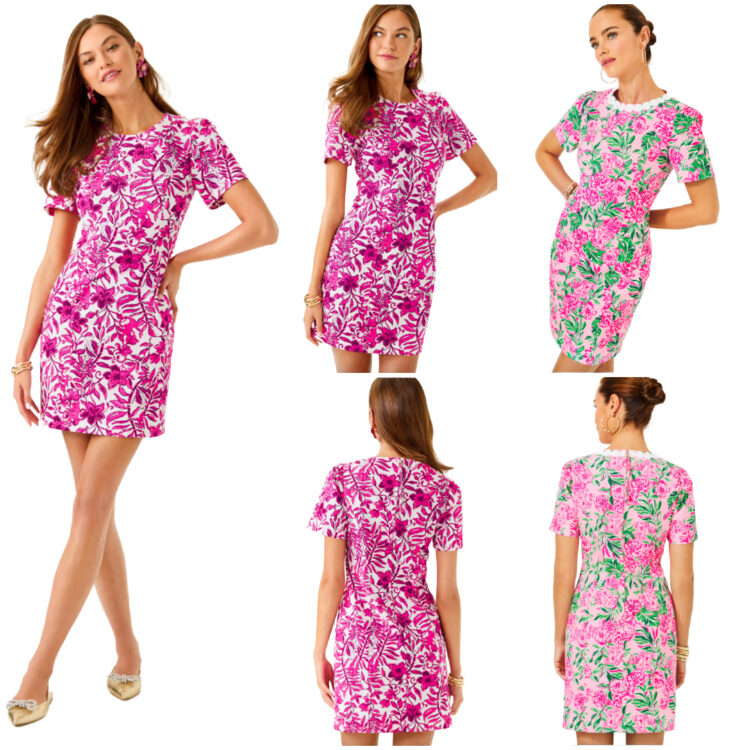
Examining the Mila Short Sleeve Shift Dress from Lilly Pulitzer
The Mila Short Sleeve Shift Dress is $198 and from 98% cotton poplin with 2% Spandex for stretch. A classic style that has been popular for decades, the Mila Dress has a crewneck, princess seaming, and short inset sleeves. It has a back zipper and hook and eye closure and the zipper has a long pull on it out of the same fabric as the dress. It comes with an extra-wide hem so you can adjust the dress length. It is available in two prints and sizes 00-16.
The Company Behind Lilly Pulitzer
Lilly Pulitzer was a real woman who asked her dressmaker to craft colorful shift dresses to hide stains from running a juice stand. She soon started selling more of her colorful dresses than juice. In 1959, Pulitzer became president of her own company. When her friend Jackie O came to visit, bought some of her shift dresses, and wore one on the cover of Life Magazine in 1962, the fashion brand took off.
In 1993, the Lilly Pulitzer brand was bought by Sugartown Worldwide, Inc., which maintained boutiques and licensed apparel to be sold in major department stores like Belk, Nordstrom, and Neiman Marcus. In 2010, Sugartown was bought by Oxford Industries, Inc., a publically traded company started in 1942 that also owns apparel brands like Tommy Bahama, Duck Head, and Johnny Was.
While Oxford Industries, Inc. wouldn't be considered an icon of sustainable fashion manufacturing, the company does uphold a Manufacturer's Code of Conduct for each of its brands, conducts regular supplier audits, and as a whole each year changes practices to run the business in a more sustainable manner (Oxford Industries 2021 Corporate Reponsibility Report).
Unlike many companies that are primarily online, Lilly Pulitzer still has 63 brick-and-mortar boutiques across the United States and sells merchandise at almost 150 boutiques and major department stores. This means U.S. labor and U.S. rent, both which are not cheap (though labor is another thing that hasn't kept up with the cost of living in this country). Oxford Industries, Inc. employees, which include Lilly Pulitzer staff, receive benefits like various types of insurance, 401K, tuition reimbursement, stock purchase plans, and domestic partner benefits.
Lilly Pulitzer's parent company, Oxford Industries, is a member of Better Cotton (BC), a global cotton sustainability program. Better Cotton is grown in 22 countries across the globe, creating 22% of the world's cotton. This program benefits laborers, the environment, and the communities where cotton is sourced. It's a bit of greenwashing, but it's also more effort than a lot of companies put forth in sourcing cotton. And that effort costs.
Let's go back to the Lilly Pulitzer $198 Mila Short Sleeve Shift Dress. No, it's likely not made by empowered women business owners in a developing country who were paid as much as equal workers in the States. The cotton is likely not organic, and who knows how the inks were manufactured to get that bold iconic print. The size range is better than many companies, but not extensive to dress a good percentage of the U.S. population. But let's compare it to similar dresses from a range of retailers.
Comparing The Lilly Pulitzer Mila Dress to Similar Dresses on the Market
Below are nine similar concept dresses currently for sale at major retailers. The Lilly Pulitzer dress is the most expensive of the nine. Below the image, I share details of the fabrication, size range, retailer, and price:
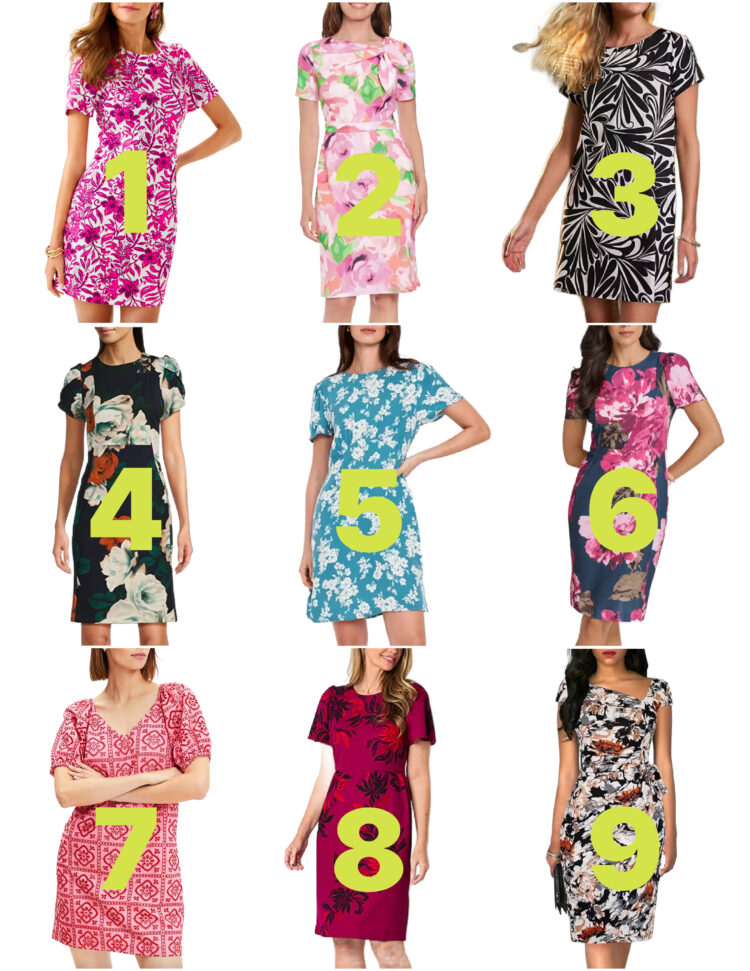
one | two | three | four | five | six | seven | eight | nine
- One: This is the dress from Lilly Pulitzer. It is 98% cotton poplin from Better Cotton, two prints to choose from, machine wash, sizes 00-16 for $198
- Two: This dress is from London Times. It is a polyester spandex blend with a polyester lining, hidden zipper back closure, machine wash, sizes 4-16 for $99
- Three: This dress is from Jude Connally. It is a “Jude cloth stretch knit wrinkle-free fabrication,” which is a polyester/spandex blend, and the dress is unlined and a pullover style without any seams for shaping. It is available in XS-XXL for $188
- Four: This dress is from Calvin Klein. It is a scuba crepe (AKA polyester), dry clean, exposed zipper back closure, sizes 2-14, and originally was $129 but is now on sale for $77.40
- Five: This dress is from Old Navy. It 100% viscose rayon and unlined, machine wash, button-loop closure at nape, side pockets, and a pleated empire waist. The dress is available in XS-4XL with petite and tall and retails for $34.99
- Six: This dress is also from Calvin Klein. It is a polyester neoprene fabric, exposed back zipper, pieced bodice for shape but the prints don't match up at the seams. Available in sizes 2-16, it is $134.
- Seven: This dress is from LOFT. It is 55% Cotton 45% Rayon with a cotton lining, pullover styling, full sleeves with elastic cuffs, machine wash, sizes XXS-XXL with petite options and was originally $99.95, on sale for $35.95
- Eight: This dress is from Liz Claiborne. It is 96% Polyester, 4% Spandex doubleknit, invisible back zipper closure, pleated shoulders, available in sizes 2-14, and while originally retailed for $74, is on sale for $36.99
- Nine: This dress is from Liyinxi, a company on Amazon. It is made from an unknown “Stretchy and Lightweight Fabric.” It is a pull-on style without any hardware, available in sizes S-XL, and retails for just under $35
Why Do These Dresses Cost Less?
Finding similar dresses at a similar or lower price point was harder than expected. As you can see, most are from synthetic fabrics, and few have the same exact concept of sleeves and closure. Let's go over the four ways to cut costs and how these were able to retail for less than the dress from Lilly Pulitzer:
Cheaper Materials
Polyester and viscose (which is a type of rayon) cost less than natural fibers like cotton. You will find such fabrics in clothing at all pricepoints, but viscose especially is one to watch out for.
While it may feel silky and nice and sounds like a sustainable fabric (made from wood pulp from quickly growing trees), viscose takes a lot of toxic chemicals to produce, and only a very small percentage of the deforestation is performed in a sustainable manner. Viscose is also prone to shrinking, especially when agitated in a machine, so while it's cost-effective, it can be high-maintenance and easily damaged or shrunk when washing.
As for cotton, not all cotton fabrics are created equal. You've likely noticed the difference between percale and sateen sheets; different thicknesses of threads, the number of threads woven in a square inch of fabric, and the softness and durability determine cotton quality. The rougher the cotton, the cheaper it is.
And when it comes to closures, we all know the difference between a delicate hidden zipper with a tiny slippery zipper pull, an exposed heavy-duty zipper that may or may not “go” with the dress concept, and a zipper with a stylish zipper pull that can be more easily reached when getting yourself dressed.
Buying in Bulk
While a bigger company owns Lilly Pulitzer, it can't hold a candle to behemoths like Amazon, Shein, and Walmart. When you supply millions of customers and own your real estate, you can buy in bulk, mass produce, and sell things for less while still making a profit.
It is impossible to compare something from Amazon to an individual retailer. The business practices are so drastically different it's truly unfair. Just keep in mind each purchase from these megacompanies makes them stronger and causes smaller companies to struggle to find ways to cut costs and stay afloat. You determine the future of retail with your wallet.
Cheaper Manufacturing
Manufacturing is hard to determine. In this day and age, retailers know they are being scrutinized and are excellent at greenwashing. Also, in this day and age, the country where a garment is created does not determine the factory's conditions, the treatment of the workers, or the ethics of the business.
However, a sign of cheaper manufacturing is the choice for a simpler design. Darts, princess seaming, and pleats are more expensive to recreate than a more relaxed fit. While it may seem more complex to piece together fabric to shape a sheath dress, it's a way to cut fabric costs and easily create a sense of shape.
Finishings are sometimes added to hide cheaper manufacturing. Embellishment like bows, ruching, pleating, embroidery, and bedazzlement are used to distract you from shoddy construction and cheaper textiles. Don't be blinded by the bling.
Finally, stretchy fabrics hide shoddy construction. It is harder to fit a cotton poplin sheath dress than a stretchy polyester version.
Technology Innovation
Some finishings and designs just can't be done with a machine. Crochet, for example, can only be done with human hands, so low prices of crocheted garments are a major red flag of unethical and likely inhumane working conditions.
Simple design that can be whizzed through a sewing machine will reduce cost for items that require more detailed work. Again, notice fitted cuffs versus straight or elasticized, pleats versus smocking or a-line design, and other methods to reduce the need for human eyes and hands on every step of the process.
Technology costs money; you are more likely to find that megacorps like Amazon, Walmart, Target, Shein, and Temu have the funds for tech innovation as they can use it across more channels and for more orders. The smaller the company, likely the simpler the technology which can increase the purchase price.
Taking all we know about the brand, the manufacturing process, the fabric, the design, and the reviews on fit and quality… I personally find the Lilly Pulitzer dress to be a reasonable price in 2025. And this entire exercise is proof of how fast fashion has destroyed our concept of price and value.
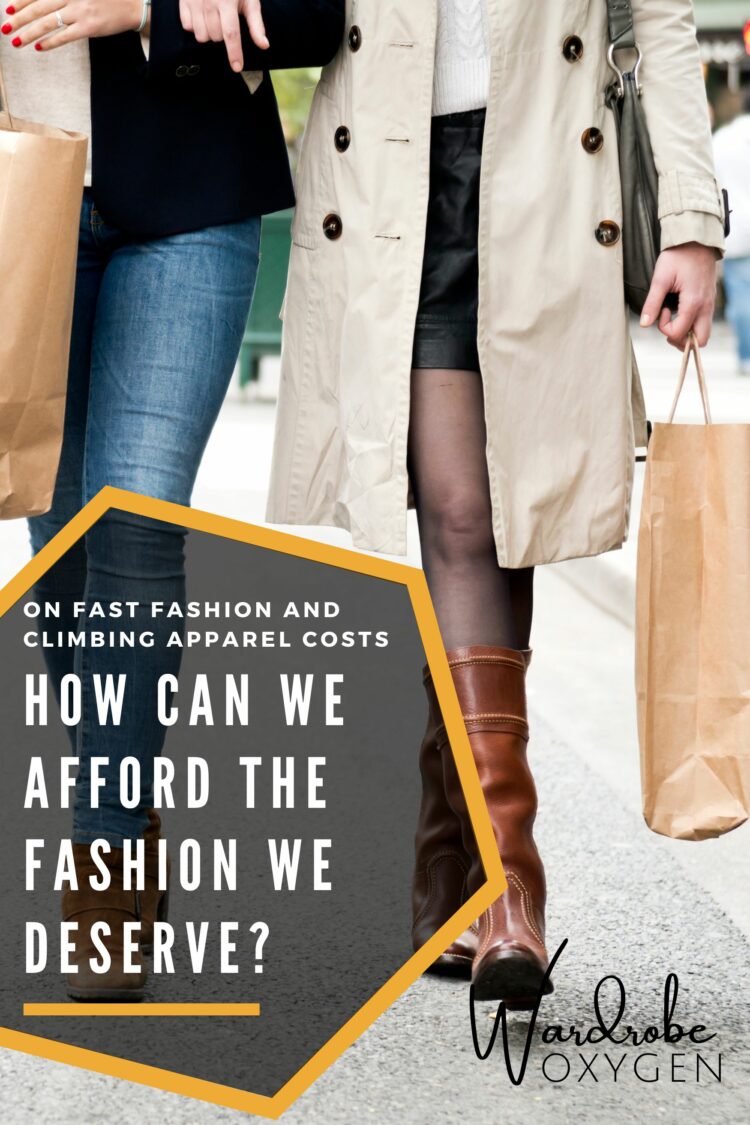
How Can We Afford The Fashion We Deserve?
So a cotton dress in 2025 is $198. That's a lot of money. For $198, you can feed a family, fill the gas tank, pay a utility bill, or buy a prescription. The things to factor in are need and personal value.
Let's be honest, no one NEEDS a colorfully printed short-sleeve shift dress with brick-a-brack along the neckline. Sure, it's adorable and would be great at a day wedding in a warm climate or to wear for your partner's work event. But likely, you already own something that will do (or can buy something that will get more wear year after year). This is a want purchase. And want does hold merit.
I See It, I Like It, I Want It, I Got It
But when it comes to wants, we've become a society that sees it, likes it, wants it, gets it. We feel the need to wear something new to every occasion versus repeating favorites to emphasize our personal style. We get so frustrated with the lack of selection, size, and fit we buy mediocrity and end up with an overflowing closet and nothing to wear.
We scroll through social media and stream series where temptation is every 30 seconds, and a device is in our hands to buy that look within minutes. And we have influencers telling us that dupes are stylish, looks for less are attainable, and life will improve with a purchase.
Is Your Closet Growing, Too?
In 2000, I worked for a company that sold jeans and several times a year I would get 55% off. Even so, I only owned a handful of pairs. Each pair was a different color or style and served a different purpose. Some were for going out, some were for weekend. Some worked with heels, some with flats. They all were worn, and all purchased with purpose.
In 2020, during Lockdown, when I did a closet cleanout, I realized had over a dozen pairs. I took the time to try them on and realized I only liked two of them. Most of them didn't have the best fit, but I didn't have anything else to replace them. Some were duplicates because it had become so hard to find great jeans that didn't wear out super quickly, and I feared a blowout or other form of denim destruction. But most were mediocrity bought and kept because I felt it was the best I could do.
The world is back to a new form of normal, and I am back to only a handful of jeans, each with a different purpose. I don't care how good of a price, if they don't make my ass look great they're not staying in my closet. If they slide down and give me diaper butt by noon, they're not staying in my closet. Returns suck, and stores don't have my size, but that doesn't justify me owning crap.
And all that crap purchased is keeping me from the money for quality. And tailoring. And energy to carefully launder and care for what I own so it lasts as long as possible.
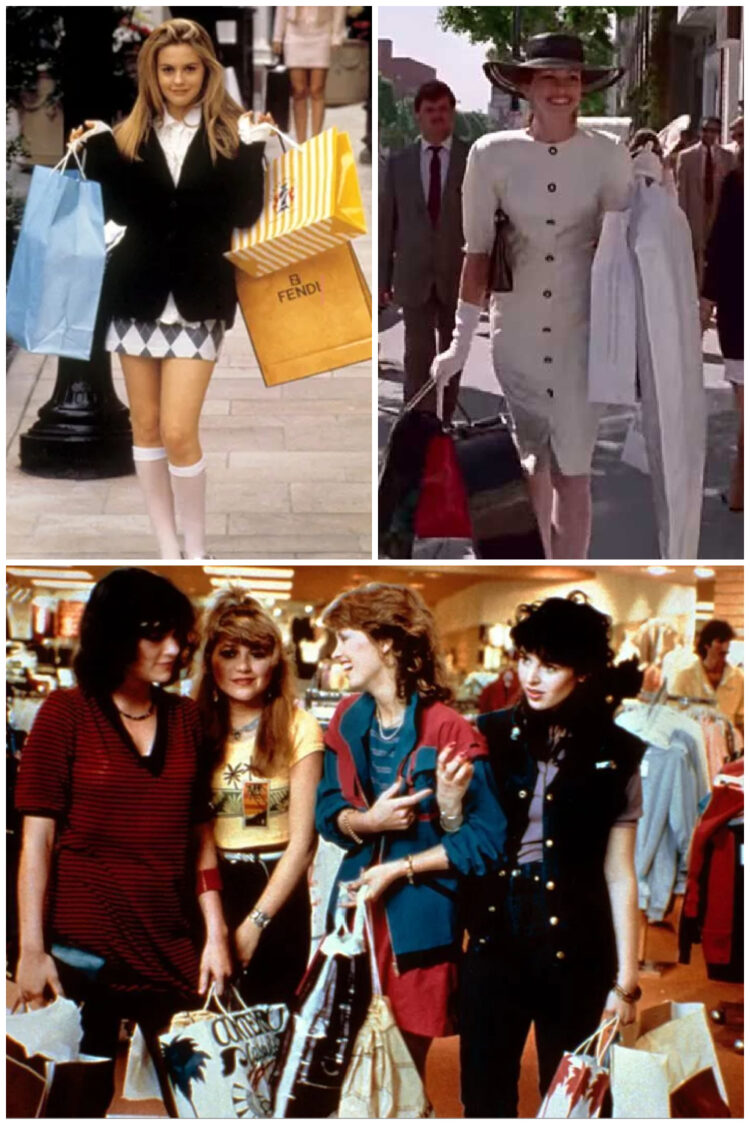
When Has Fashion Been Easy?
When has fashion ever been easy? We have some Pretty Woman Clueless Valley Girl fantasies about spending all day at the mall and leaving with the ultimate dream closet. But I don't think we ever experienced that in our grown-ass woman lives.
I know when I was an adorable 20-something, I'd often go to the mall and come home empty-handed. Okay, I'd come home with an empty Nordstrom Ice Storm cup and a random pair of earrings or socks, but no perfect apparel to change my life. Jeans didn't fit my ass, shirts didn't fit my bust, blouses didn't fit my arms, necklaces didn't fit my neck, sunglasses and hats didn't even fit my head. But back then, I left them at the mall.
You don't need half the stuff that is in your closet, and you likely don't need more. You're rarely buying out of need, you're buying out of desperation and FOMO. And I know Wardrobe Oxygen is part of the problem, recommending earrings, offering links for current fashion trends, and showing off my personal fashion on Instagram, often linking my items on LTK for easy shopping.
But buying crap and complaining how clothing is too expensive is just destroying our concept of price and value and veering us so incredibly off course from finding personal style.
Does Cheap Quality Fashion Exist?
I love clothes and fashion, and if you're here reading Wardrobe Oxygen, you likely do, too. Fashion is an art, it's a hobby, it's a form of self-expression, and I know I'd be utterly miserable wearing the same thing over and over and over, especially if I didn't love it in the first place.
I am not expecting you to trudge through life wearing your current closet until it wears out, or you rip it off your body, throw it into a bonfire, and race down your city streets in your skivvies screaming, “I'm finally freeeeee!” But I am asking you to realistically consider the price of things in 2025 and compare them to the current cost of clothing. You'll see things aren't adding up, and by succumbing to these fast fashion prices, you're making things even worse.
Budget-Friendly Reliable Retailers
Some retailers do cheap fashion better than others. I often recommend Old Navy because while they may have problematic practices, they offer size inclusivity, natural fibers, the occasional sustainable practices, and a way to embrace trends and newness without looking dated or having garments fall apart in less than a season.
I am also a fan of J. Crew, Gap, and Banana Republic factory stores, which often have style and fit that rival or exceed that of their parent companies. I personally have a Gap Outlet dress in my closet that is older than my teen daughter.
Secondhand is so Chic
Current trends are perfect for thrifting, consignment shops, vintage fashion, and buying secondhand online. The return of '90s and Y2K style, how runways are embracing street style and creativity, and bajillions of TikTok, YouTube, and Instagram tutorials to DIY tailoring, upcycling, and customizing clothing for your needs are all ways to add newsness to your closet without spending a fortune.
When it comes to brands like Lilly Pulitzer, head to Poshmark. While writing this piece, I found so many Barbara Tops on this resale app as this is a style Lilly carries often, just in different prints and fabrics depending on the season. You'll also find a lot of Lilly Pulitzer on eBay and can often rent styles at Rent the Runway.
If this sounds time-consuming, remember how it was to shop in 2000. We didn't have stores at our fingertips. We took time, touched fabrics, made lists, and made comparisons. It may have taken weeks or months to find the right something. Life is faster in 2024, but that doesn't mean your closet has to move that quickly. We can't slow down time, but we can slow down our shopping.
Fashion is Art… and a Hobby
I know lately I have felt unmoored and overloaded. Experts will say you need a hobby that isn't connected to screens or your job. Why not take up sewing? Or knitting? Or embroidery? Or paracord knotting? Or crocheting? Or quilting? It can calm your mind while keeping it working into the second half of life, and it can also add a badass personal touch to your style.
Shop for You, Not Them
Fashion is so accepting these days, it's a good time to embrace your roots or try something new. Who were you in college? What did you love to wear in your 30s? What style did you always admire but feel wasn't for you because you were too much something or not enough something else? Now is the time to try it.
I remember seeing a woman on the Metro wearing an oversized denim jacket, dark denim jeans cuffed over combat boots, underneath a black turtleneck. Her jacket was covered with patches and pins, her salt and pepper hair was in a messy updo, her earrings didn't match, and her tote was made out of hot pink fake fur. The only makeup on her grown-ass woman face was brows and a berry stain on her lips.
She looked so incredibly cool and chic and current, even though I can believe she has had those boots and that jacket for decades. And the jeans and turtleneck were so simple they could have been thrifted, or bought at Old Navy, or at Saks.
Start small with what is in your closet. Tuck in that which you usually wear out. Play with proportions, pairing volume with volume, long with short. Try a combination of colors or prints that normally wouldn't come to mind. Add a belt. Or a wacky sock. Even if you just wear it at home, get a feel for this change, and catch your reflection in glass cabinets, windows, and mirrors.
We often shop when we feel stuck. But sometimes freedom is already in our possession. If you need some inspiration in place of the dopamine hit of clicking “buy,” check out my Starting Style from Scratch series, which will continue throughout 2025 and in my newsletter (click here to subscribe)

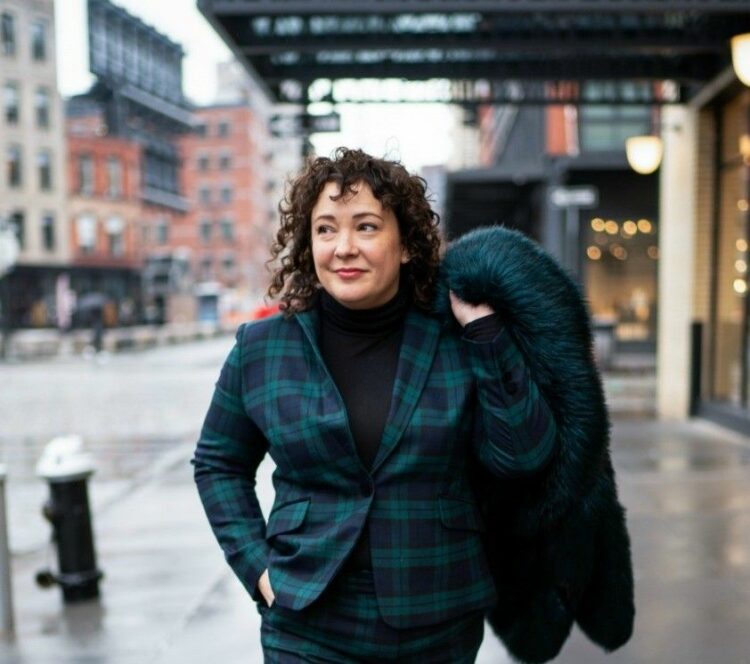

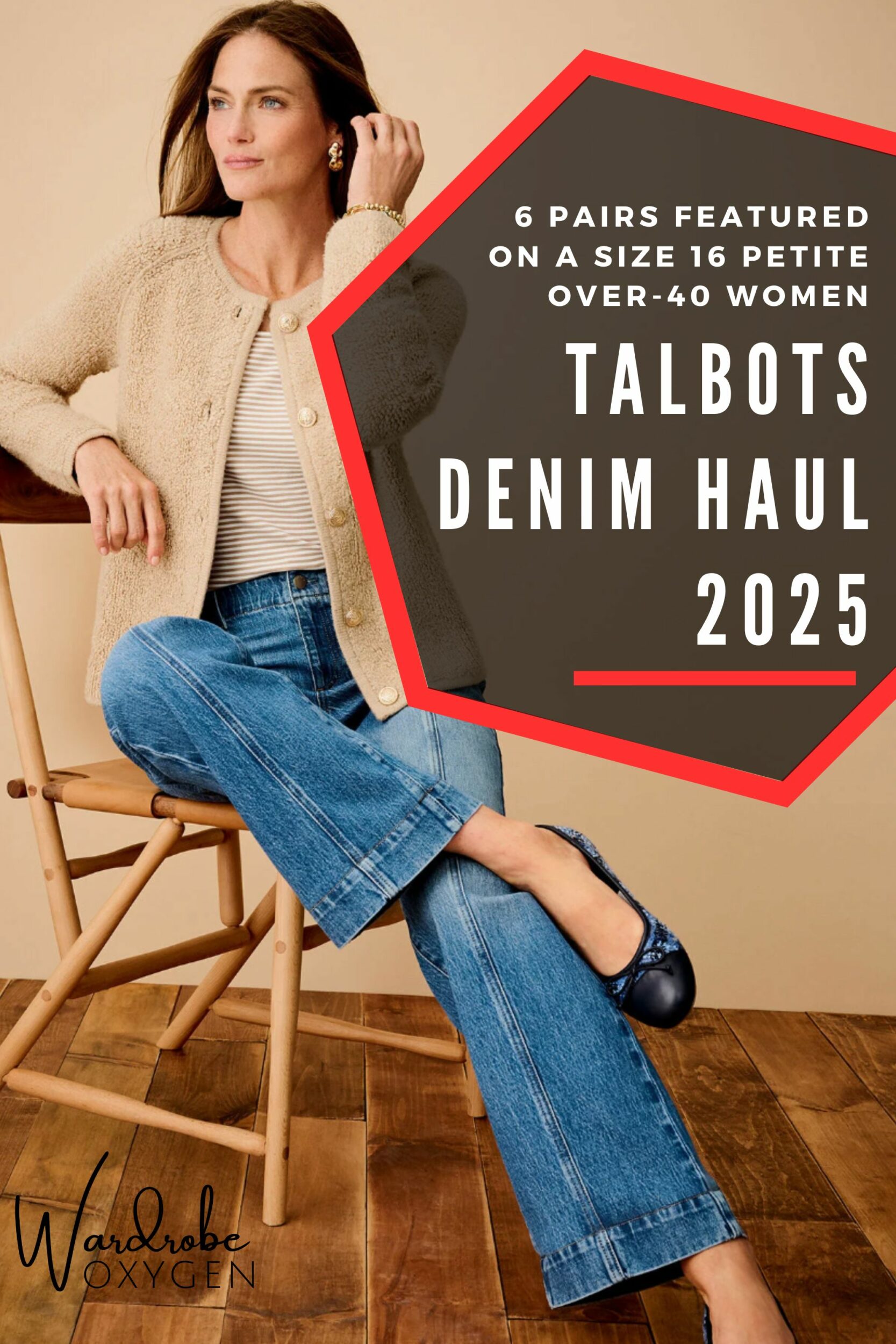
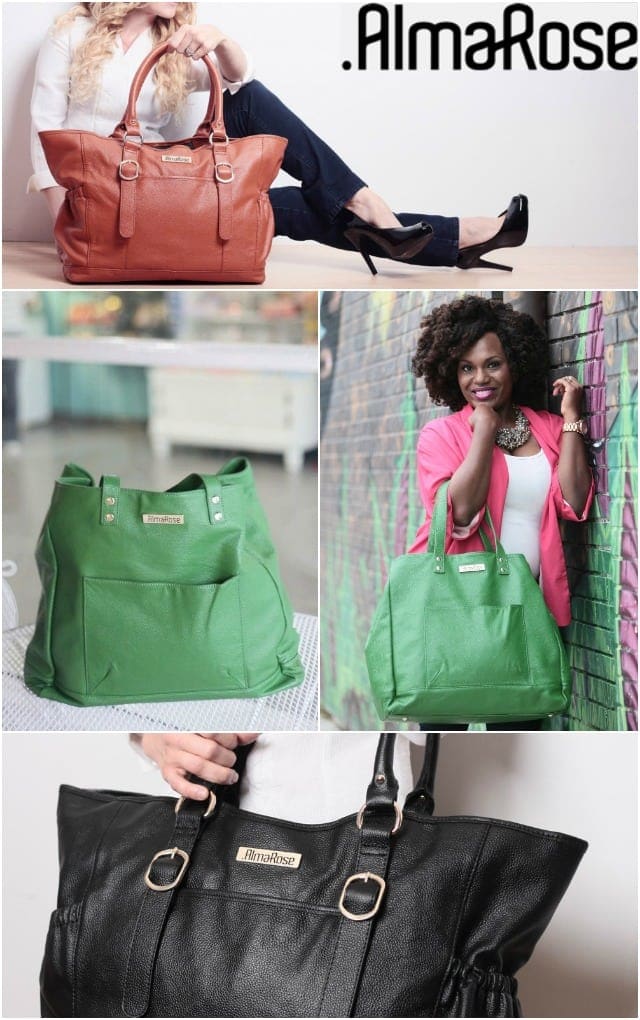
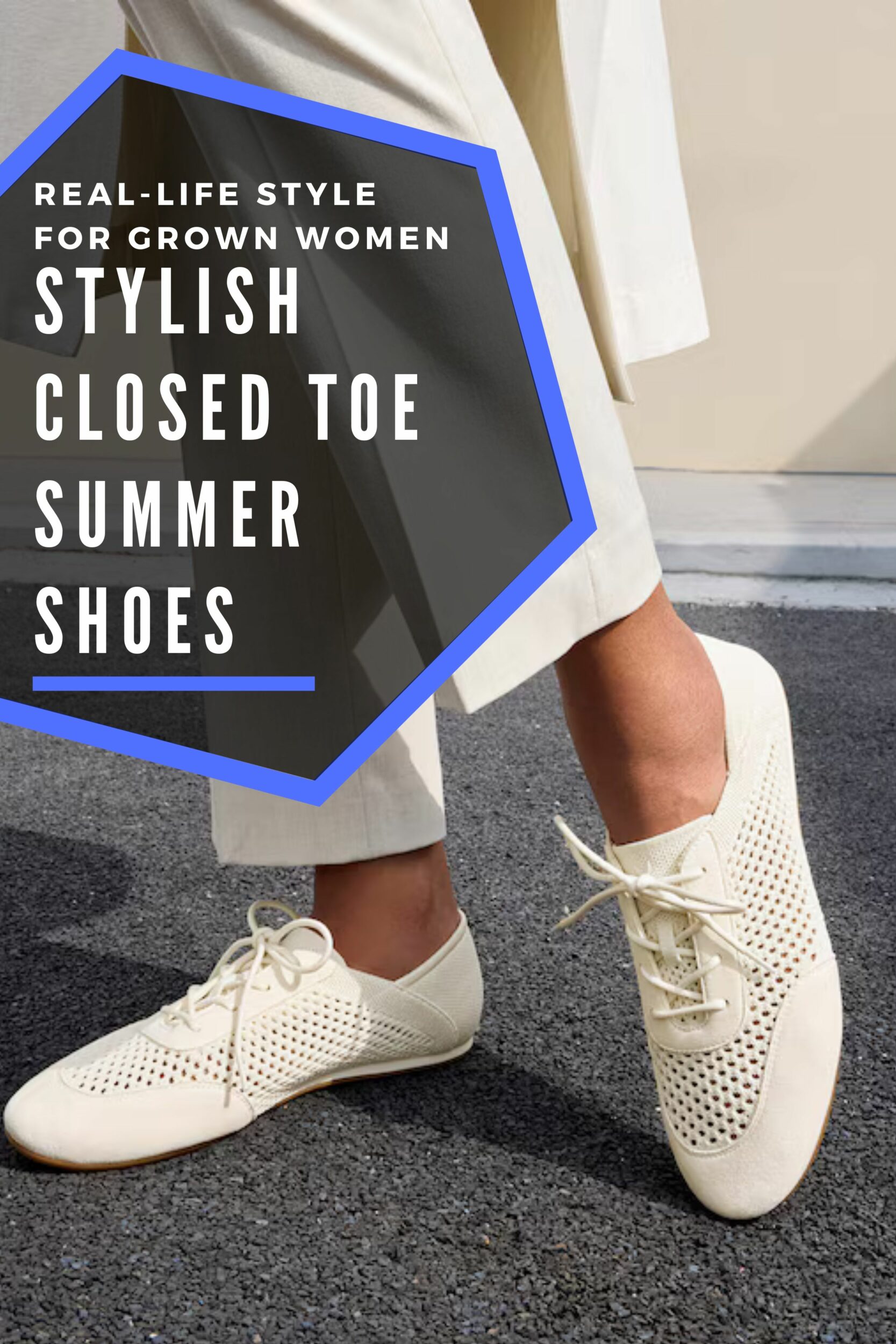
Excellent article. I think back to the high quality of Talbots in the late ‘80s and early ‘90s. I invested in 100% wool flannel trousers fully lined at a price of $118. Most synthetic pants at Talbots in 2025 cost less. It is nearly impossible to find similar quality for even twice the price even in DC. LL Bean and Lands End used to be a place with high quality 100% Shetland wool sweaters. In 2002 Chico’s sold gorgeous embroidered denim jackets and artisan blazers, an amazing 100% linen machine washable pants. I willing to pay more, but I’ve found Etsy is the way to go.
It’s near impossible to find the quality we expected and found so easily back in the ’80s and ’90s. Etsy, the RealReal, Poshmark, eBay, Mercari, vintage and consignment stores are the way to go and funny enough, Talbots is easy to find as folks don’t realize the old stuff was goooood.
So much this. I hardly ever buy in stores. So much feels flimsy and not meant to last. I don’t want clothes made of plastic. I recently bought a vintage 80s long wool coat off Poshmark and the quality and heftiness is incredible to anything I attempted to buy new. Fast fashion is a disease. If you can’t see yourself wearing something 50+ times should you be buying it? That’s the attitude I have had in the past couple years. It’s not perfect, but I refuse to buy stuff that doesn’t feel good to touch and isn’t supporting my values. More and more I am concluding that every dollar I spend is making a statement about my values and SheIn is not it.
Very interesting article. Thank you for your time and sharing! What do you think of Quince?
Thank you Alison for this very insightful column. Might I add something that I have thought about a lot. I was raised in a family that was very strapped economically, as well as emotionally chaotic and it took me years to realize that my attitude towards any kind of shopping was a response to what I have heard described as “poor brain”. In other words, the temporary satisfaction of coming home from the mall with “something” can make you feel better for a while, less left out from the riches of your society. Now that I am older and more prosperous, I still sometimes grab a sale item just in the hopes that it will fit and look OK. I live in the downtown core of my city where there are 3 very good clothing stores and I walk by them daily. It’s very difficult to not be lured by their occasional sales. What we have done, now that we are retired, is set a monthly budget for all purchases and so I really need to think hard about clothing purchases. It’s a difficult discipline and the temptation to buy to get that “feel good” effect will never leave. I think that if impulse buyers, like I once was, step back and reflect a bit on what propels the purchases, then it might be a little easier to not fall for the impulse. Like you, I enjoy looking put together, but want my shopping to be thoughtful, slow, and truly productive. So thank you for once again reminding us of how important it is to be a thoughtful and intentional consumer. But I must admit that as a Canadian, I am struggling right now with buying from any US company like Talbot’s which has been my main source of clothing for the past 15 years. One of the stores near me carries some wonderful Canadian brands but with blouses at $500 and suits at $1500 that’s just too far a stretch for me.
Thank you for this timely and insightful post. I recently went through a closet purge. I found that the clothes I love and decided to keep are the ones that I spent “too much” money on. They have made every cut from previous purges and I still wear them. As I looked at them I realized that I’m not keeping them because they were relatively expensive, but because they are well-made, enduring styles, and fit me well. Cost per wear over the years is literally pennies. And they’re not boring. I have mostly basics but also some signature pieces that I have had for years that I regularly mix with the basics. At age 74 I think I can still look modern and uniquely me by shopping my own closet. I haven’t given up shopping altogether and will occasionally add a trend to my wardrobe. I often find that the “trends” are already in my closet (leopard, flared/wide pants, leather, burgundy, even fringe LOL)
The clothes I let go were good quality and were welcomed at a women’s shelter. Much better than tossing no longer wearable fast fashion into the trash.
I grew up in lower middle class family in the Midwest. We took care of our clothes. Seams and hems had enough fabric to adjust the fit when needed. We mended clothes as necessary instead of tossing them out and buying new ones. We polished or buffed our shoes and resoled them (are there any cobblers around anymore?).
More than anything, it is important to me to set an example for my children and grandchildren about sustainability and value for money.
Such a good post, Alison—thank you. Lots for me to think about here. I am guilty of buying more for different reasons—I’m stressed out, I’ve got an event, I’ve gained weight, and I just enjoy clothes and shoes, etc. Also, I think there’s a part of the adult-me who remembers the teen-me who couldn’t buy a lot of trendy clothing because of financial reasons & so now that I can afford more, I want more. Following blogs and influencers on Instagram does not always help either (this is not shade on WO; I’ve followed you for over 12+ years and still think you’re the best). It’s fun to see new clothes, shoes, bags, etc. and think about where I could wear those things. Still, I need to pause and really think about what is needed and useful as opposed to just what’s wanted. Over the weekend, I did a very tiny bit of closet clean out and was rather shocked at the amount of clothes I took out for the donation pile. My community has a buy-nothing type group, so I have been making good use of it by passing along clothes to others who want them. But, I still have way too much, I know.
Good info. I’m just starting a major overhaul using your “Starting from Scratch” series. I spend time at my two different homes (no, not elite, main house bought 39 years ago, small urban apartment thanks to really frugal grandparents). I never seem to have what I need at either place.
Though they are two very different lifestyles, the basics are needed in both places. Packing and unpacking from my wide assortment of clothes isn’t working, and I don’t like most of them anyway.
My plan is to acquire two sets of the basics. Not buying the exact same thing twice, just the same category. I hope I will then be able to switch the wardrobes back and forth during the year.
Today’s post is reminding me to add a more serious layer to the list of qualities I want in each piece.
I have $2000 to get started. (OK, I’m a little privileged). I’m sort of looking forward to this exercise but I expect it isn’t going to be easy.
Another great article! I have always valued quality over quantity, but I do occasionally fall into that, “I want something new to wear – NOW!” trap and, you know, nine times out of ten, the article ends up in the Goodwill bag within 3-6 months. I am striving to be a more mindful shopper, taking things like materials and where they’re sourced and where the item was manufactured into account. These are things that should be included in the specs for the item you are considering purchasing. If that info isn’t available, or very hard to navigate to, you probably don’t want to hit that add to shopping cart button.
Thank-you, yet again, for a very interesting and revealing article.
To quote: “We have lost all concept on value and cost because of these fast fashion mega-companies.”. Err, no. It is because mega-companies have customers. If no-one bought from them, they wouldn’t survive.
It is the greed and hypocrisy of the fashion consumer (largely female – call me a misogynist, if you will) who fuels the trade.
You are holding up a mirror to the majority consumer. Well done.
I think that *is* misogynist. Where exactly do you think these mostly female consumers get the idea that they need new clothes all the time? Push on your assumptions a little bit and you’ll see the *man* behind the curtain. The money here is still, as always, in mostly male hands.
If I may, I’d like to quote the essay
“So a cotton top in 2024 is $128. That’s a lot of money. For $128 you can feed a family, fill the gas tank, pay a utility bill or buy a prescription. The thing to factor is need and personal value.”
Now I’ll confess. I am the original poster of the now infamous complaint about the $128 blouse.
I wish I could spend $128 on one blouse. I am sad that I can’t.
But I’ll keep wearing what I have and live vicariously through those that are able to afford $128 for one blouse.
I am glad you wrote what you did. You are not alone in not being able to afford a $128 top. Retail is all out of whack and it makes a bigger disparity between the haves and have nots. The middle class is disappearing and forcing us to resort to questionably created apparel.
Thanks for this great post–it’s so true! I used to regularly purge my closet twice a year, but in the past 5-10 years I’ve stopped because once I get rid of something, it will be nearly impossible to replace with the same quality. Most of my clothes are 10+ years old. I have wool and cashmere sweaters from 1980s/1990s that are still in great shape, but have paid $100+ for similar sweaters in the past decade that either pill or get holes within a month.
Close to retirement, working from home and leading a very casual life, I barely need any clothes anyway. I’m not really on socials so I’m not seeing the “influencers.” Combined with the fact that shopping just isn’t fun anymore (either travel to stores with a dearth of selection and sizes, or buy a bunch of clothes online that end up not fitting and schlep them to UPS), it’s become very easy not to buy new stuff. Thrift shopping/resale websites are too much work for me.
All of this has helped me kick the retail therapy habit, which has streamlined my life considerably. That said, I still miss the days when a trip to the mall was exciting and fun!
I’m really glad to see you write on this subject. In addition to unequitable and downright abusive manufacturing practices, fast fashion is one of the biggest polluters in the world today. It is contributing to the destruction of the environment and of local markets and economies–it’s just that it is primarily affecting people in the global south, so we are able to ignore it from our comfortable lives in the U.S.
It’s nearly impossible to avoid fashion brands that have questionable (at best) labor and environmental practices, and it can be so hard to find real, hard facts of each brand’s impact because they work very hard to obscure them. And even those brands that tout their sustainable and fair labor practices can’t wholly control or ensure visibility into their manufacturing partners’ practices. Some very large popular legacy brands also even cheat their manufacturers out of payment for the product they’ve produced. It sucks all around.
As someone who has sewn a lot of my wardrobe, I’ve had to face the fact that even that practice isn’t as sustainable as I’d like due to fabric manufacturing practices and environmental impact, and I have a decided preference for natural fibers. But I also love rayon and bought a lot of it in the past before I understood the impact of its manufacture. It’s almost impossible to find any good information on a specific big-box fabric’s sourcing.
It’s all a little depressing and a lot frustrating. The solution seems clear: buy less, use less, repair more. But it’s very hard to resist the draw of new new new. Especially when so much of it is rock-bottom cheap. I keep reminding myself and anyone within earshot that if an item is so cheap I feel like not buying it would be stupid, then at minimum someone is not getting paid and that someone probably really needs to be paid for their labor. The whole “cheaper COL in X global south country” is a bit of a red herring. Corporations have a vested interest in influencing the politics in those countries to ensure continued cheap manufacturing. It’s the East India Company all over again. And unfortunately the people most adversely affected are women and children.
Sorry for the novel. It’s an incredibly vexing issue and you’ve covered a large portion of its problems in this post, and I’m really glad to see you bringing this topic to your audience.
Thank you for writing what I have been thinking for the past year or so. Your article is well researched and presented.
I appreciate the effort and sentiments expressed.
Great read! I visited from Marsha blog. Nice to meet you and yours!
Welcome, Nancy! Any friend of Marsha is a friend of mine!
This was a fabulous post, so informative and thoughtful. Thank you!
Have you gone back to school? This reads like a well researched term paper! If I were grading it, you’d earn an A+! Well done.
Aww thank you, Jo! Nope, I just love to write and do some Google digging!
I appreciate the way this article places value on sustainable manufacturing, paying a living wage, and sustainable consumption but I think two additional important truths were left out at the beginning that also factor into the way people have increasingly turned to fast fashion over the years:
1. Salaries have not doubled in the past 20 years; and
2. The increase in the price of gas, housing, and cars has just as much to do with artificial shortages (see, e.g. housing crisis) and corporate profiteeing (see, e.g., the amount of inflation driven by profit in the past 2 to 5 years versus the past 20 to 50 years) as with increases in the costs of raw goods, manufacturing, and labor.
Unlike housing and, in many parts of the country, gas and cars, clothing (particularly as fashion) is a much more fungible and discretionary purchase.
With these factors in mind, I think that buying secondhand and buying a few quality pieces over numerous cheap fast fashion fixes makes even more sense.
This was a great read, and you are one of my top 3 favorite fashion bloggers because of how you keep it real. Thank you!
Yup. This. While everything Alison says is true, fashion is not the only industry where average people can no longer afford the quality that they once could. Restaurants and retail stores are all finding that the middle is gone–we have Nordstrom or Target, but department stores are going bust; fast food or high end restaurants, but chains like Applebees are really struggling. Influencers or people who follow that aesthetic and want to wear a new outfit every day certainly exist, but not in large enough numbers to drive the demand for fast fashion. A much bigger problem is how much the middle class has been squeezed, and for how long. Alison’s analysis applies well to shoppers who have choices, but much of the demand for FF is driven by those who don’t.
I am glad you wrote this post. I used to like Talbots, but I feel like most of their tops are some form of polyester. With some input from my daughter, I now try to buy second-hand items that are cotton, linen and wool. I did order a Universal Standards box and two out the three items were rayon or Viscose. Ugh! I miss clothes that don’t stain, keep their shape and last forever. I am willing to pay more for better quality, no fast fashion for me anymore. I wear what I like and don’t worry about current trends.
I think the article is very interesting and true. The perception is value. You can buy less expensive, and sometimes that even makes sense. But you get what you pay for. Personally, I like the wardrobe capsule concept. I can build my wardrobe around a set of clothes, pay the higher prices, get the quality I want, and most importantly, I wear the pieces. Do I have some pieces in my closet just sitting? Yes, and I need to purge those!
Maybe purge, or maybe see if you find them in a new light with a new year! I don’t necessarily think a smaller closet is always better, but I do think we can’t find our style in a cluttered closet!
Thank you for writing this – it’s excellent. I haven’t bought fast fashion for many years now, but I was guilty of sometimes buying an article of clothing just as a way to fill my lunchtimes when I worked a corporate city job. Then I moved to a property in the country a few years back, where I don’t need nice clothes and there’s certainly nowhere to buy them except online. So I buy almost nothing. Just recently I have really been feeling that I would love a couple of things that make me feel excited about getting dressed, so I’m going to scour the thrift stores and an amazing consignment shop in my nearest city, I really appreciate the timing of your article because it’s reinforced my determination not to just ‘add to cart’ because I’m feeling bored or restless.
I’m so glad you liked it!
Well said and so true. I try to thrift most things other than technical clothing and underwear and I’d rather have fewer better things. Fast fashion is all too often made by people who are essentially living in slavery or abject poverty so indulging in it is bad for people as well as bad for the planet. Disposing of all the junky fast fashion people wear a few times and dump is an increasingly terrible environmental problem. Articles like this one help since we all need to be more aware – the value proposition of clothing reaches further than our own closets!
Thank you, Leslie!
I am VERY appreciative of this article! I do not order clothing from Amazon and so many influencers promote Amazon clothing. When I shop in my local boutiques, I know that while paying more, I am helping keep small businesses going. Plus what a sad world we would have if our ONLY source of clothing and shoes are from mail-order Amazon. No thanks!
I’m so glad you wrote this post. It’s also extraordinarily timely. PrePan, I was making a serious effort to ensure that nearly all my clothing purchases were secondhand. Then, beyond the usual bad things that impacted all of us during the pandemic, truly terrible *additional* events hit our family. I have found I’m self-soothing STILL with cheapo purchases for that dopamine hit. Your writing here is a good reminder to reconnect with what I love about fashion and to save up for the better things that last … and actually make me happy.
I often write pieces like this as a reminder for myself, too! I do find I shop far more when I am stressed or dealing with really terrible things. It’s a quick dopamine hit but has so many negative side effects.
Absolutely. So true. I was just listening to the podcast Maintenance Phase and they identified a quick self-test to at least slow your roll when you’re about to make a bad decision — HALT. Are you Hungry, Angry, Lonely, or Tired? Then maybe wait to do the thing.
And if you still want that dopamine hit? See if your local thrift shop, eBay, or Poshmark can satisfy it 🙂
LOVE Maintenance Phase!
Here, here. Do so appreciate this well-written article, Allison. You really brought your expertise to bear. Like reader Kelly I am almost entirely buying my clothes used. The clothes I buy all have natural fibers and are still in pretty good shape after twenty-plus years because they were well made to begin with. I find shopping new and in-store much more difficult since stores are all cost-cutting and swapping in nasty 5-material blends and rayon and polyester because they are cheaper. It’s a discouraging future that lies ahead of us if fast fashion continues to dominate.
Fully agree. I am so glad that social media darlings are really making vintage and thrifting so chic. But what will be in thrift stores in a few years if folks keep buying cheap crappy clothing?
I’m already seeing that here in the Midwest. In Goodwill it’s a sea of polyester blends and rayon from places like Shein. Even in the “good” consignment stores, 75% of the pieces are made from modern construction with poor quality fabrics. The difference between a “quality” piece from the mid 90’s to now in 2025 is staggering. No linings, no tacking down of seams…even “good” fabrics like cotton/wool are not the same quality as before. I really wish we could do a rewind on retail fashion and quality.
I’m interested in hearing your thoughts on how the Great Recession (07-09ish) may have played into or accelerated this trend. From my perspective it felt like before that was the last time I remember having consistently higher quality clothes in stores, then the recession happened and I remember many stores having to put things on super sale…everything always 50% off, etc. to get people to buy. Recession ended but brands claimed consumers weren’t willing to pay the old prices again, that they still wanted everything for cheap and the always on sale prices. But as a consumer it felt like stores wanted me to pay the old high prices for quality that was no longer there and the idea of that was unappealing. I remember having beautiful wool dress pants from Ann Taylor with lining that I’d splurged on but didn’t mind because they fit, moved well, lasted, etc., yet suddenly I had to pay the same price for something cheap and thin with no lining. It felt like the upper end stores did a bait and switch. I don’t actually know how much quality pants like that would or should cost today but I’m willing to pay for quality…I just can’t find it anymore. Even really high end brands are using bad fabrics, shoddy sewing, etc.
Yes! This a better framing of what I was noting below!
Yes! This is 100% true! Well said.
It could be that, but I also know around that time a lot of retail brands filed for Chapter 11 or were bought by bigger corporations. Ann Taylor was one of them; they got bought by a company that also owned like Dress Barn and the quality and style dropped dramatically. I can’t recall perfectly, but I feel that New York & Company, The Limited, and a few others got hit hard by the recession and tried to come back but at a cheaper scale. I need to go through my archives at that time, I feel I wrote a lot about the change in retail due to the recession but it has completely slipped my memory (though I recall my high school best friend’s phone number!)
I almost exclusively buy secondhand for myself right now. For my kids and husband, I am constantly looking at the quality-price tradeoff. In my experience, I am sometimes pleasantly surprised at how many wears I can get out of a polyester or blend blouse. What makes me crazy is the expensive stuff that still ends up being low quality, but you only realize it after it has faded, shrunk, or developed a hole 30 days in. See also- sweater moths! This is why I sometimes end up in fast-ish fashion; I’d rather be pleasantly surprised vs bitterly disappointed!
I just had to let you know that this was a well- thought out and written piece. I thoroughly enjoyed it. And I 100% agree with everything you’ve written even though I am guilty of purchasing fast fashion. Thank you for your thought provoking post.
I grew up with a mom who sewed and in turn I sewed. Thru college and my professional life I made many of my clothes so I could afford more clothes. I also made many of my children’s clothes. Because of this I have a very critical eye toward construction and am often appalled by even expensive clothes that are poorly made. Great article for so many readers. Thank you for all this clarification.
I always appreciate how value-conscious you are and there are so many ways to be stylish and money smart that you mention here. Thanks!
What a thoughtful, informative article. Yours is one of the few blogs that does more than push merch. Thank you!
Love this post! I’m lucky to be at a point in my career where I make enough money to be able to be thoughtful about what and where I spend my money. I almost only buy secondhand clothes (except for things like pyjamas— from Printfresh— or underwear). We eat out at local restaurants rather than chains, and make food choices based on treatment of the people and animals who produced it. I’m also thoughtful about how much we buy; we have a house that was built in 1946 and while large by global standards, it’s small to US eyes. Thank you for recognizing the complexity of this issue, but also pushing us to think critically about it.
Awesome article. As someone with a background in the apparel industry, it’s tough out there. Cheers to the US companies hanging in!! I’d rather have fewer high quality pieces than wear cheap clothing made with very questionable labor.
This article is so well researched and so well written. It is so thought provoking and puts into perspective so many aspects of “fashion” and how everyday life has evolved. Thank you.
Thank you for such an honest piece. I appreciate how you call out the fine line between writing about and promoting fashion, and sticking to quality and buying less. As a fashion influencer, I can’t imagine how difficult that is. There’s just so much hypocrisy going on in social media — women pushing body positivity AND ozempic, aging gracefully while getting a face lift, buying the “look for less” while touting quality and ethical manufacturing, etc. This is one of a handful of sites I trust for complete transparency.
Posts like this are the reason I follow your blog. Thank you for this very important, interesting and timely information.
Thanks Alison! Another great think piece on fashion and the choices we make. I ordered something from Wool& recently and on their packaging was written “live simply.consume carefully.do good.” I love that!
Great article and very well said. I saw the facebook post and it made me grimace a bit because of everything you just wrote.
Thank you, Susan! And I hope it doesn’t seem like I am shaming that person. What they said is how so many feel and I completely understand why! I just wanted to provide some background to help us all become more informed of consumers.
Fantastic article! I often struggle with balancing those cheap and shoddy options with more costly, higher quality ones. Unfortunately with everything else going up in price, the wants that often affect our fashion purchase decisions end up near the bottom of budget priorities and so many people feel forced to buy cheap brands in order to fill those wants. But as a sewer and knitter, I really hate the poor quality of items (my mom always said to me if you are taking the time to make something, buy good quality materials, because otherwise you spend this time and effort and you won’t be happy with the result). This was a great reminder to switch up the way I pair items and to delve a little deeper into the why of a purchase, and then if it’s justified, spend a bit more to get something great. I’ve also found myself going back to more hand made clothing and taking the time between seasons to pack up the off season stuff, that way they feel fresher the next season because I haven’t seen them for a while (and it forces me to put my hands on each item so I see them again instead of them being stuffed in a back corner of the closet)
A personal stylist told me the key to really wearing all my closet is to have all of it in there, all year round. And so I did that. And then my closet got a bit full and I decided to pack away the off-season pieces. And it made me excited to wear them again the following season! It’s like when you find a $10 in your winter coat the first time you put it on after fall!
Thanks for the very thoughtful post. I would add, and I think you’ve said this previously Alison when writing about fast fashion but didn’t notice it in this post, it has a tremendous adverse impact on the environment. It’s also such a vicious circle. It would seem to me that in some cases people embrace fast fashion because of low paying jobs and the stores that offer low wages are the same ones selling fast fashion. Thanks for the insightful post.
You are so right, Marla. I didn’t get into it because some brands like Adidas, which one wouldn’t think of as fast fashion, creates some of the most clothing waste in landfills. Unexpected, right? Overconsumption as a whole is destroying our planet!
I’m so glad you wrote this. I am going to share it all over the place. Super well done.
Thank you so much, Grace!
Thank you for this – it’s wonderfully informative, and I appreciate the self-honesty and invitation to self-honesty! For me, the exercise of recalling what I wore when I was last expressing myself (instead of what I was told my shape or age called for) was a joyful and healing experience, and is helping me reconnect with what clothing and styling actually makes me happy. It feels worthwhile for that reason all by itself, even if it didn’t also help me be wiser with my spending.
I love that you’re doing that, Holly!
Great article that makes you think. Very timely also. Have a blessed week!
Thank you, Jenice!